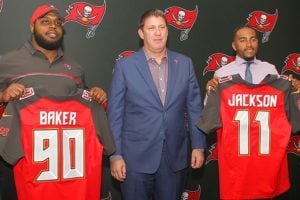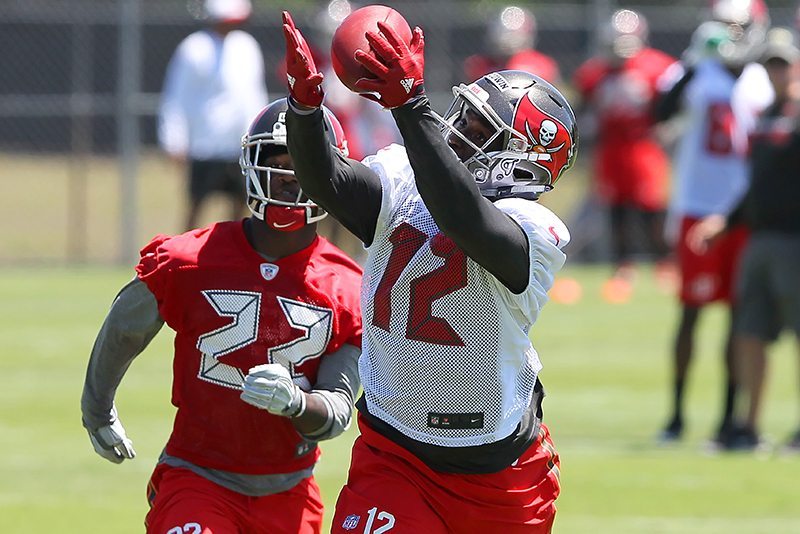SR’s Fab 5 is a collection of inside scoop, analysis and insight from yours truly, PewterReport.com publisher and Bucs beat writer Scott Reynolds. Here are a few things that caught my attention this week at One Buc Place and around the NFL.
FAB 1. BUCS BUILDING ROSTER FROM THE BOTTOM UP
There’s no doubt that legendary Buccaneers cornerback Ronde Barber’s 92-yard pick-six in the 2002 NFC Championship Game at Philadelphia was the greatest play in franchise history. Barber’s signature play sent Tampa Bay to its first and only Super Bowl and should help his chances of making the Pro Football Hall of Fame when he becomes eligible for the first time.
 Barber was one of the many stars on Tampa Bay’s 2002 Super Bowl team, and those “A” level players came through big time in the Super Bowl XXXVII win. Hall of Fame linebacker Derrick Brooks had a game-clinching pick-six in the fourth quarter of the Super Bowl that culminated a season in which he was named the NFL Defensive Player of the Year. Brooks ended up with five defensive touchdowns in 2002.
Barber was one of the many stars on Tampa Bay’s 2002 Super Bowl team, and those “A” level players came through big time in the Super Bowl XXXVII win. Hall of Fame linebacker Derrick Brooks had a game-clinching pick-six in the fourth quarter of the Super Bowl that culminated a season in which he was named the NFL Defensive Player of the Year. Brooks ended up with five defensive touchdowns in 2002.
Hall of Fame defensive tackle Warren Sapp had 7.5 sacks during the regular season and added another in the Super Bowl. Defensive end Simeon Rice, who had 15.5 sacks in 2002, had two QB captures of Rich Gannon a week after sacking Donovan McNabb in the NFC Championship Game.
Legendary fullback Mike Alstott scored the Bucs’ first post-season touchdown in Philadelphia in Tampa Bay history – a feat that had eluded the franchise the two previous seasons – as well the team’s first touchdown in Super Bowl XXXVII. But as great as Barber, Brooks, Sapp, Rice, Alstott and strong safety John Lynch were for the Bucs during that magical season, there were several other solid contributions from necessary role players that made Tampa Bay Super Bowl champions.
There are three ingredients to producing Super Bowl teams. The first is having Pro Bowl talent – grade “A” talent, if you will. The second is coaching. Getting the most out of that talent with proper usage, timely play calls and game management is critical, especially in the postseason.
But the third ingredient is often overlooked and undervalued. Improving a team’s roster from the bottom up is vital. That means replacing the grade “C” players with “B” players.
A quick look at New England’s most recent Super Bowl roster shows only four Pro Bowlers from last year’s team – quarterback Tom Brady, linebacker Dont’a Hightower, defensive back Devin McCourty and wide receiver Matthew Slater, who made the Pro Bowl as a special teams ace. In terms of talent and ability it’s more than fair to add four-time Pro Bowl tight end Rob Gronkowski, who missed half of last year due to a back injury, to the Patriots’ group of “A” players.

Patriots TEs Martellus Bennett & Rob Gronkowski & RB LeGarrette Blount – Photo by: Getty Images
But the reason why the Patriots won the Super Bowl was because the rest of the team is comprised of mostly “B” level role players from running backs LaGarrette Blount and James White to receivers Julian Edelman and Chris Hogan to tight end Martellus Bennett to cornerbacks Malcolm Butler and Logan Ryan to nose tackle Alan Branch and defensive end Trey Flowers and a solid, yet unheralded offensive line.
Future Hall of Fame head coach Bill Belichick knows that a sure-fire way to get beat in today’s NFL is to have a “C” level player that can be targeted for mismatches, so he spends his offseasons in free agency and the draft looking for a host of good, solid role players that are perfect scheme fits.
Belichick knows that he can win with a couple of “A” players and several “B” players, but a team with “A” players and too many “C” players is the recipe for a defeat. Belichick also knows that “B” players like Butler and White are capable of wining big games – even Super Bowls – but “C” players can’t.
That’s what new Bucs head coach Jon Gruden knew in 2002 and why he and general manager Rich McKay spent their first offseason together upgrading the roster, especially on offense. The plan wasn’t necessarily to find “A” players, but “B” players that could win games – clear upgrades over the “C” players on Tampa Bay roster that held the team back in the playoffs in 1999, 2000 and 2001.
Here’s a look at how the Bucs upgraded their roster in 2002:
2002 LT Roman Oben over 2001 LT Kenyatta Walker
2002 LG Kerry Jenkins over 2001 LG Randall McDaniel
2002 RT Kenyatta Walker over 2001 RT Jerry Wunsch
2002 TE Ken Dilger over 2001 TE Dave Moore
2002 TE Rickey Dudley over 2001 TE Todd Yoder
2002 WR Keenan McCardell over 2001 WR Jacquez Green
2002 WR Joe Jurevicius over 2001 WR Karl Williams
2002 DE Greg Spires over 2001 DE Marcus Jones
2002 MLB Shelton Quarles over 2001 MLB Jamie Duncan
The Bucs decided not to get into a high-priced bidding war with running back Warrick Dunn and the Atlanta Falcons, so they signed Michael Pittman as his replacement, which was a bit of a downgrade at the running back spot. Pittman had a good season, but not a great one in his first year in Tampa Bay, but this “B” level running back did rush for 124 yards in Super Bowl XXXVII. And he wasn’t the only “B” caliber player that shined in the Super Bowl.

Ex-Bucs FS Dexter Jackson & CB Brian Kelly – Photo by: Getty Images
McCardell had two catches for 13 yards, but both were touchdowns. While Keyshawn Johnson was Tampa Bay’s leading receiver in 2002 with 1,088 yards, it was Jurevicius who led the way in the Super Bowl. Fresh off his key 71-yard catch against Philadelphia in the NFC Championship Game, Jurevicius had four catches for 78 yards in the Super Bowl win and landed on the cover of Sports Illustrated the following week.
McCardell, Jurevicius and Pittman weren’t the only “B” players that shined for the Bucs in Super Bowl XXXVII. Dexter Jackson – not Lynch – was the playmaking safety in San Diego and recorded two interceptions to become the Super Bowl XXXVII MVP. And it was Dwight Smith – not Barber or Brian Kelly (another “B” caliber performer who led the Bucs in interceptions with eight that year) – that starred against Oakland, setting a new Super Bowl record with two pick-sixes.
It can be argued that Tampa Bay’s “B” players were just as valuable – if not more – than the Bucs’ “A” players against Oakland in the team’s lone Super Bowl win.
I recently spoke to Barber about this topic of championship caliber teams needing to upgrade their rosters and finding “B” players to replace “C” players.
“Jason has consistently told me that they need to better build the bottom of the roster,” Barber said. “You need those guys to be able to be players. Keith Tandy is a great example of quality depth.”
Here is what the Bucs have done this season in terms of upgrading their roster from “C” caliber players.
2017 WR DeSean Jackson over 2016 WR Vincent Jackson
2017 WR Chris Godwin over 2016 WR Cecil Shorts/Freddie Martino
2017 TE O.J. Howard over 2016 TE Brandon Myers/Austin Seferian-Jenkins
2017 RB Jeremy McNichols over 2016 RB Peyton Barber
2017 LB Kendell Beckwith over 2017 LB Daryl Smith
2017 S Justin Evans over 2016 S Bradley McDougald
2017 K Nick Folk over 2016 K Roberto Aguayo

Bucs DT Chris Baker, GM Jason Licht & WR DeSean Jackson – Photo by: Cliff Welch/PR
Time will tell if these are indeed true upgrades from “C” or lower caliber player to “B” level players, and if Folk ultimately beats out Aguayo, or if last year’s second-round pick rises to the occasion and beats out the veteran. The Bucs feel they’ve also upgraded – albeit slightly – at nose tackle where Chris Baker is believed to be better than Clinton McDonald and at center where Ali Marpet has a chance to be better than Joe Hawley.
The key to Tampa Bay making the playoffs and having a chance to advance is not having obvious weaknesses at certain positions that can be turned into mismatches by opponents. Licht and Koetter took a big step towards achieving that goal by upgrading the Bucs’ roster from the bottom up.



